Singapore’s ageing heritage hawkers hope for successors; one has put up recipe for sale
Times are tough, especially for hawkers in the business district. The programme On The Red Dot meets two masters of the trade whose decades-old legacies might be lost if things do not change.
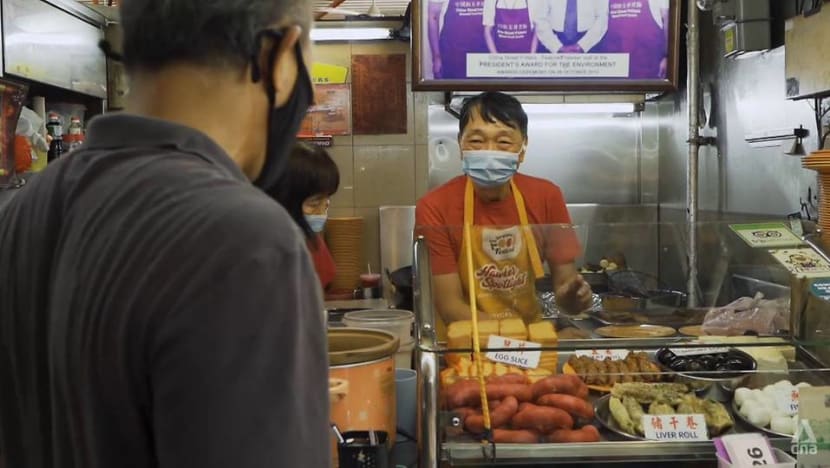
Ng Kok Hua has survived decades in the hawker trade. But age is catching up with the 64-year-old.
SINGAPORE: Maxwell Food Centre hawker Ng Kok Hua started helping out at his father’s stall when he was in Primary Six. He took over when he was 16 and has been plying his trade ever since.
In the beginning, he took a bus to China Street after school to help wash the plates and serve mainland Chinese cuisine to customers.
At night when the stall had closed, his father took him to sample other hawker food in nearby Amoy Street, Boon Tat Street or Pickering Street.
“So (it didn’t feel like) I was coming to help my father, (but rather like) I was coming for the good food,” he recalls.
When he was in Secondary Four, his father fell ill, so Kok Hua left school before his GCE O levels to continue the business and support his nine siblings.
“As a 16-year-old student, suddenly (I had to) take over the whole stall. It wasn’t easy,” the 64-year-old tells the programme On The Red Dot. “I was thinking the rest of my brothers were all still studying, so no choice.”
Some five decades later, he still starts his day before sunrise.
He heads to Upper Boon Keng Market at 6am to buy items such as bean sprouts, chives, spring onion and pork before meeting his wife, sister and brother at their central kitchen in MacPherson.
They spend roughly six hours preparing Hokkien-style ngoh hiang — consisting of meat rolls flavoured with five-spice powder, egg slices, liver rolls and pink sausages — using a recipe passed down from his father.
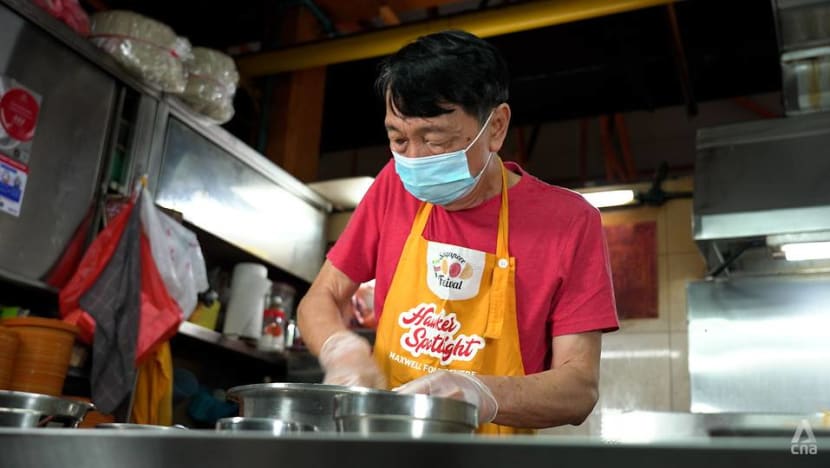
His brother, Richard Ng Kok Eng, 65, arrives at Maxwell Food Centre around 11am to take pre-orders, and the others follow with containers of handmade ngoh hiang an hour later.
Their day does not end after closing the stall at about 8pm.
“We have to go back to our central kitchen to do some preparation for the next day. By the time we reach home, it’d be something like 10.30pm or 11pm. Every day it’s like that,” says Kok Hua.
The family-run business, China Street Fritters, is one of only two stalls left in Singapore that sell Hokkien-style ngoh hiang.
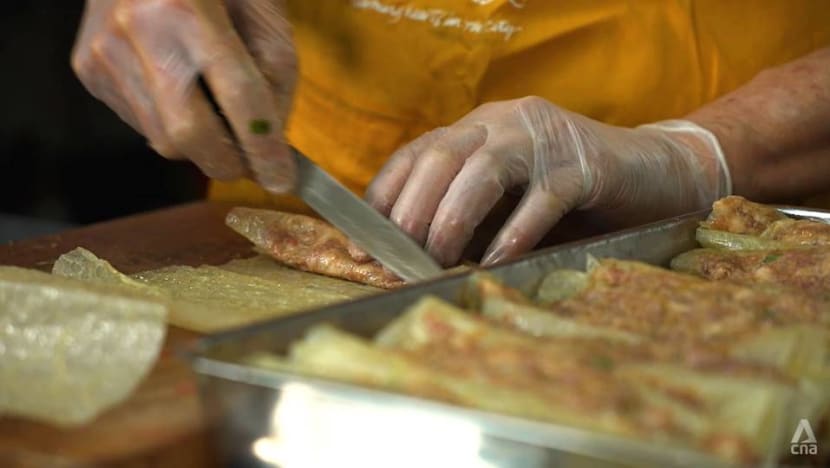
With plans to retire by next March, the family made the news earlier this year when they offered their recipe for sale at S$1 million.
Kok Hua tells On The Red Dot the sum of money, to be divided among the team who run the business, is “not a lot”.
“This S$1 million, divided by five, is only S$200,000 per person. It’s for retirement,” he says. “Age is catching up with us. My wife has to go for knee surgery, then I have to go for ankle surgery.”
Neither his three children nor his brothers’ children are interested in taking over the business, and the team is willing to sell the recipe to an outsider.
WATCH: One of Singapore’s last handmade Hokkien ngoh hiang may be gone soon (3:22)
He has seen a few hawkers at Maxwell Food Centre simply calling it a day when the younger generation was unwilling to take over. “It’s a pity that all the traditional food just goes down the drain,” he says.
The median age of Singapore’s hawkers is about 60. And while the challenge of finding successors has simmered for years, COVID-19 has made it even tougher.
READ: To save an old-school ‘zi char’ stall from COVID-19, a family comes together
‘YOU ALL MUST CONTINUE’
China Street Fritters saw a potential investor pull out when the pandemic hit.
“The company said, ‘We’ll hold the project,’” recounts Kok Hua. “It’s because they lost money in other sectors. They weren’t willing to come up with money to invest in other things.”
Richard chortles as Kok Hua quips: “Maybe it’s fated. Maybe it’s the spirit of our father trying to tell us, ‘You all must continue.’”
WATCH: A Hokkien ngoh hiang recipe worth S$1 million (2:40)
At 63 years old, fellow Maxwell hawker Ng Chow Gee, who sells duck rice and duck noodles, is also hoping that fate intervenes “soon” to bring a successor, since his children are “chasing their dreams”.
Lamenting that “youngsters now aren’t willing to take hardships”, he says he hired “a few young workers” decades ago and taught them how to wash the ducks and prepare the spice mix. But they were not serious about the trade or could not take the rigour.
He, too, began by helping his father out. His family lived above their stall on China Street, and as a young boy, he used to walk past everyone’s stalls and look.
“I’d ask them, ‘What are you cooking now?’ Some, if they were in a bad mood, would say, ‘Kid, just watch, don’t ask so many questions,” he recounts.
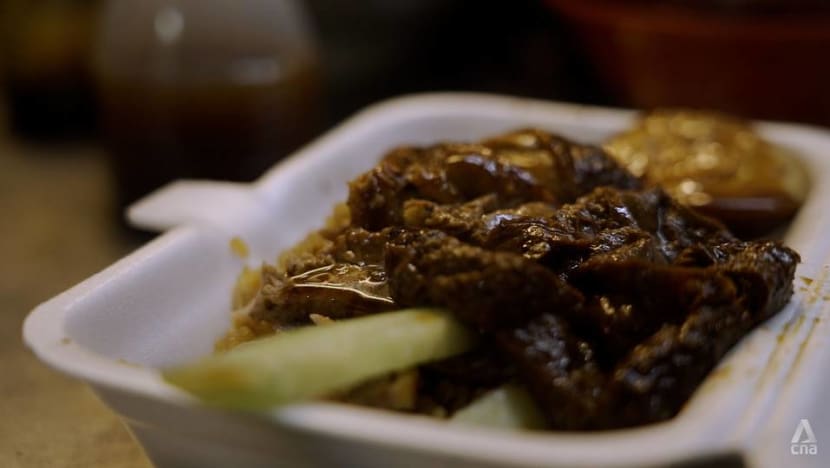
When he was 13, his father lost a helper — his elder sister had got married. Chow Gee told his demoralised dad that he would stop studying to help out. The senior Ng told him to “think it through properly”.
“I said, ‘I won’t regret it. Let me help you.’ From then on, I helped him sell and cook duck rice.”
READ: 91-year-old hawker behind historic wonton noodle stall calls it quits
READ: Can a millennial hawker rejuvenate her great-grandfather’s zi char stall?
His father died in 1981, and Chow Gee took over the business. He experimented and developed a recipe using herbs and spices such as licorice, cassia bark, Sichuan pepper, fennel and star anise. He also tenderises the meat before braising it for over an hour.
“Initially, I was struggling to decide whether I should use these spices because the price was quite high. My mum asked, ‘Our profit margin is so thin, will you earn money?’” he recounts.
But he persisted, and business improved. Before the pandemic hit, his Oriental Stall — which he runs with his wife — sold 12 to 15 ducks a day. But sales are now down to two to three ducks a day.
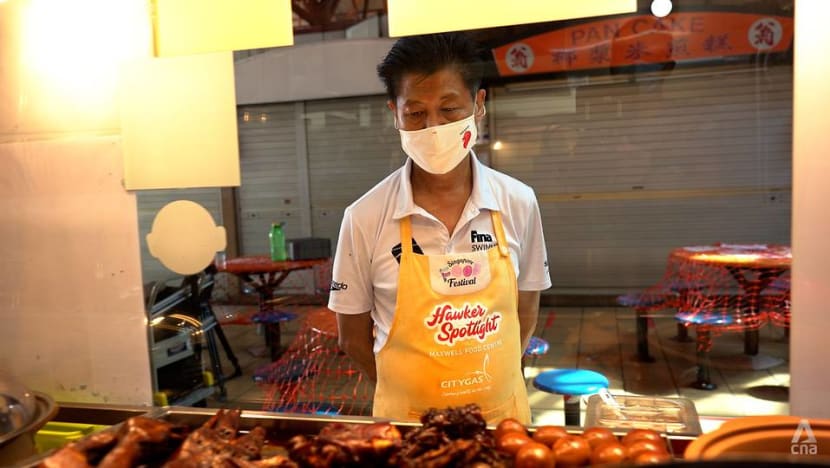
When filming took place during the Phase Two (Heightened Alert) from May 16 to June 13 — with no dining out allowed — he still had one and a half ducks left after lunchtime.
“These last two years have been really bad,” Chow Gee says ruefully.
Despite this, he does not want to retire. “The hawker centre is our first home. Our home is like a hotel. We go back to shower and sleep. When we wake up, we come down here, and we’re here the whole day, in this home,” he says.
READ: Does hawker culture have a future in Singapore? Yes, but perhaps not as we know it
READ: Floundering in digital wave, older hawkers could call it quits — taking a piece of Singapore with them
‘THE WORLD CAN’T COME’
Before the pandemic ground air travel to a halt, Maxwell Food Centre was popular with tourists. A former market, it was turned into a food centre in 1987 and housed many street hawkers who were originally from the China Street area.

If Singapore loses its heritage hawkers like those at Maxwell, it would lose a “big part” of its hawker culture, says food blogger Leslie Tay.
Singapore’s hawker culture earned its Unesco Intangible Cultural Heritage listing last year, and “we wanted to show the world our hawker heritage”, he adds. “But now, the world can’t come.”
Hawkers in the central business district have suffered a bigger blow, with most office workers holed up at home.
Unlike pricier restaurants, hawkers have found it harder to get on food delivery platforms, because the fee imposed would mean increasing their prices. Many hawkers want to keep their food affordable instead, says food blogger Seth Lui.
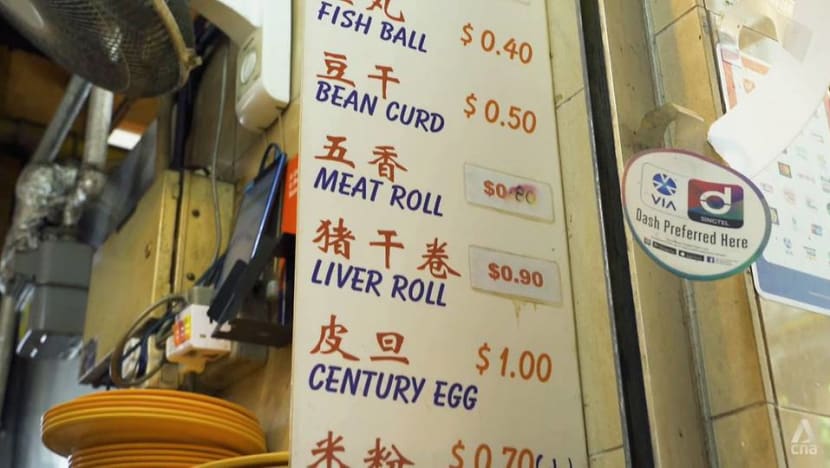
“Some of these hawkers expressed to me that they feel bad having to increase the price of their food just to have it on the delivery platform,” he says. “They feel bad for the customers.”
It is hawker food fans like Tan Han Kee who are keeping some of their favourite stalls going. He has been buying from China Street Fritters for over 50 years — his grandfather and father were customers, as are his children.
He knows this familiar ritual would end if Kok Hua and his family retire. “It’s sad because all my childhood hawker stalls are going, one by one,” he says.
Richard says that if there are no takers for the family recipe, the “worst-case scenario” is to record it for their descendants.
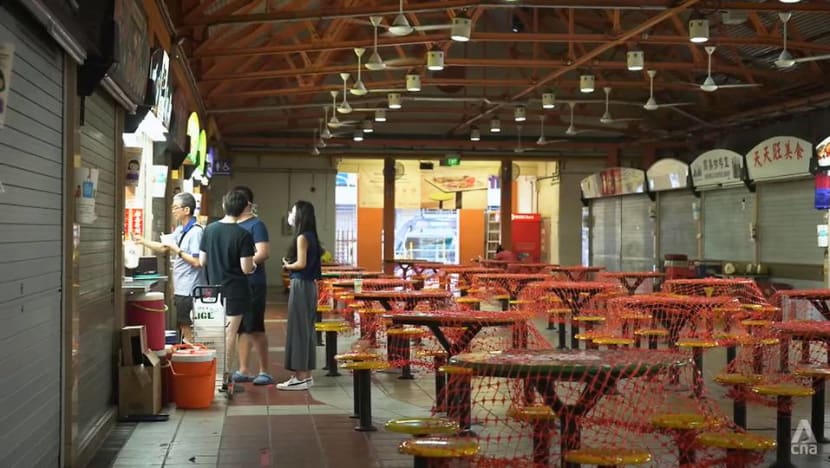
A food critic had advised them to do this, saying, “Who knows (if) some day, somewhere, your third or fourth generation … would like to be involved in (the food and beverage business)? They can bring out this so-called treasured recipe to continue the legacy.”
Richard himself joined the family business full-time in 2000 at his mother’s behest. Decades earlier when his father fell ill, he could not take over the business despite being the oldest son (and the third of 10 children) because he was under contract to an employer.
After spending 30 years in the corporate world, his duties at China Street Fritters now include marketing and social media.
WATCH: Hawkers in Maxwell Food Centre: Keeping the legacy alive (23:54)
Oriental Stall’s Chow Gee has also written down his recipe in a notebook in case his children want to use it in future.
But for now, the hawkers continue to labour hard each day. “I find that working as a hawker — long hours, humid environment, sacrificing family (and) friends — at the end of the day … is worth it,” says Kok Hua.
Watch this episode of On The Red Dot here. The programme airs on Channel 5 every Friday at 9.30pm.












